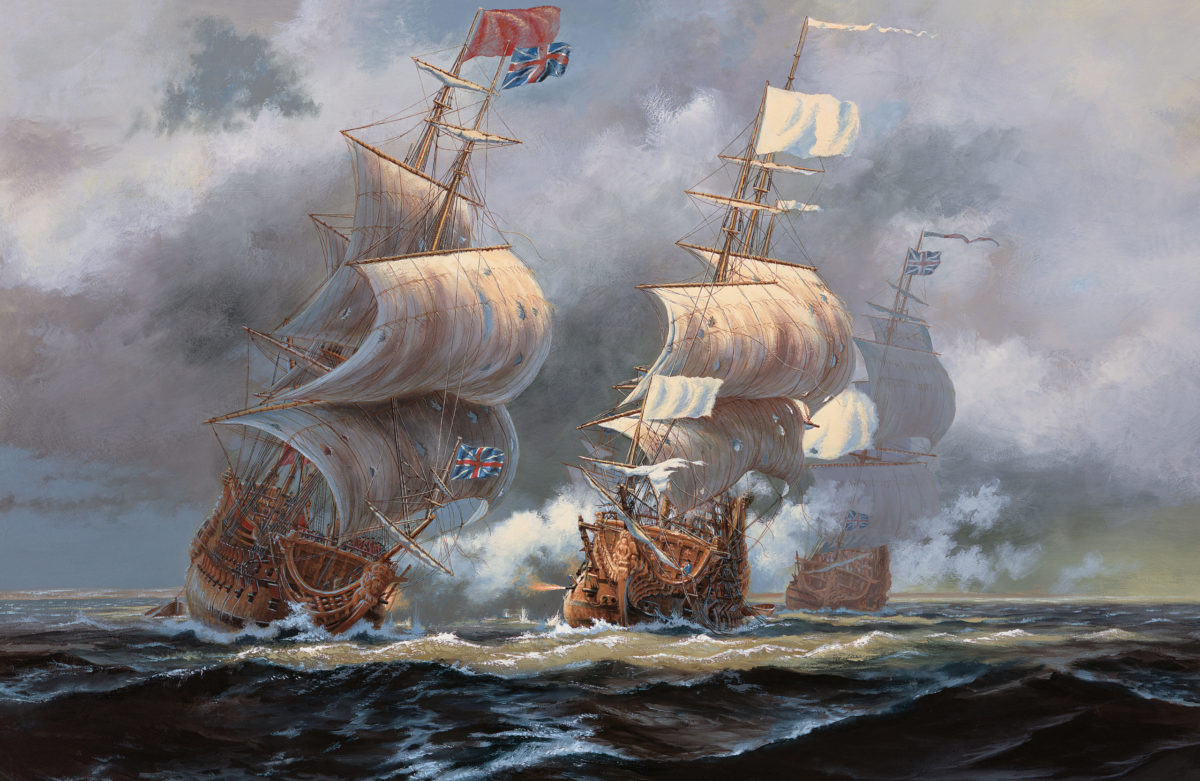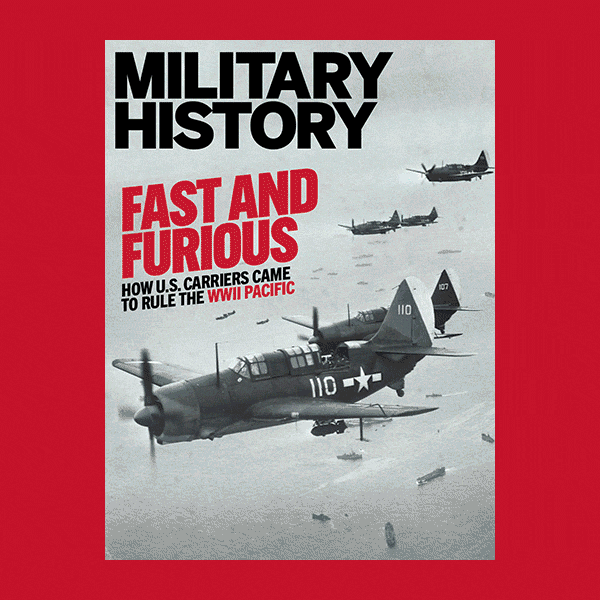Three hundred twenty-five years ago—on Sept. 5, 1697—wooden warships from England and France waged a bitter, hours-long battle in Hudson Bay. Though long since forgotten, the clash marked the largest naval action ever fought off what today is far northeastern Canada.
What historian Peter C. Newman called “the greatest Arctic sea battle in North American history” pitted the French fourth-rate ship of the line Pélican, commanded by Pierre Le Moyne d’Iberville, against English Capt. John Fletcher’s fourth-rate frigate HMS Hampshire and two armed merchant ships. The brutal fight epitomized the struggle between the rival European powers to control the newly discovered, largely unknown and potentially lucrative lands just south of the Arctic Circle and led to the largest transfer of territory in the New World to date.
Hudson Bay
Hudson Bay was named after English explorer Sir Henry Hudson, who first probed its reaches in 1610–11 at the behest of the Dutch East India Co., only to be set adrift by mutineers and left to an unknown fate. It is the second largest bay in the world (after the Bay of Bengal), with a surface area of some 470,000 square miles. If measured by shoreline, however, Hudson Bay is the world’s largest. Unlike many other large bodies of water, it is relatively shallow, with an average depth of only 330 feet.
Hydrographically an extension of the Arctic Ocean, Hudson Bay extends from 62 degrees north latitude at its southern limit to 66 degrees north, just a few miles south of the Arctic Circle. Geographically part of the Precambrian Canadian Shield, the shoreline is generally rocky, with shallow vegetation typically classified as boreal forest trending to tundra in its northern reaches.
James Bay, extending from the southeast end of Hudson Bay, is often viewed as an appendage of the larger body of water. Named after Welsh explorer Thomas James, who reconnoitered its shoreline and islands in the early 1630s, it is the outlet for scores of freshwater rivers that drain in a northerly direction and flow through Hudson Bay toward the Arctic Ocean, becoming saltier as the waters mingle. James Bay is some 275 miles long by 135 miles wide and also quite shallow, with an average depth of 200 feet.
The shorelines of both James Bay and southern Hudson Bay are festooned with numerous smaller bays, inlets, marshes and floodplains, though hundreds of shoals and rocky bars make inshore navigation treacherous. The overall catchment area of the Hudson Bay region is vast—nearly 1,500,000 square miles—extending across present-day central Canada into the Northern Plains of the United States.
A Struggle Over Settlements
During the last few decades of the 17th century the quest for dominance over the Hudson Bay region inflamed tensions between France and England. Incorporated by English royal charter in 1670, the Hudson’s Bay Co. (HBC) began trading with the various Amerindian groups in the northern settlements, while the French had the lands to the south firmly in their grasp, with control of the St. Lawrence River anchored on their citadel at Quebec City.
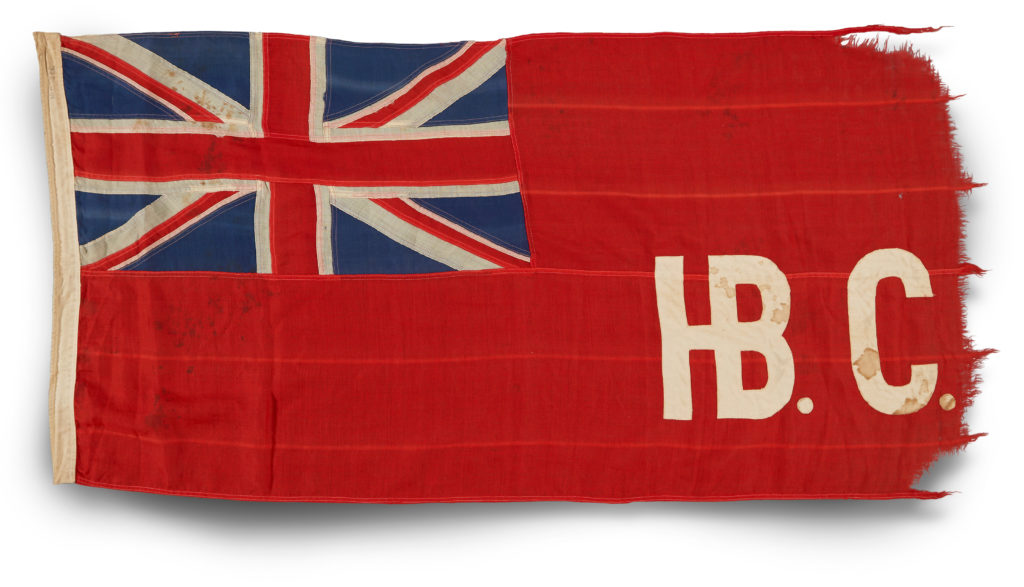
In colonial North America the initial trading settlements (often given names like fort, factory, house and post) comprised little more than wood-and-stone buildings staffed by a few traders, adventurers and the odd administrator. Such “forts” were rarely manned by trained troops, as it proved logistically problematic to deploy soldiers to remote locations and even harder to provide them with the necessary support, especially when waterways froze over during the region’s harsh winters.
For much of the late 1600s, as English and French adventurers traded with local Inuits and Amerindians, posts regularly changed hands and names depending on who had more armed men on hand. For example, York Factory, just inside the mouth of the Hayes River on the western shore of Hudson Bay, was known at various times as Fort York, Fort Bourbon and Kischewaskaheegan (Cree for “Big House”). As newcomers were unfamiliar with the topography and weather, they often had to relocate their posts due to high tides, winter storms and flooding deltas. Given their transient nature, the structures themselves were hastily built.

In 1682 Quebec-based financiers seeking to counter the growing economic reach of the HBC formed the Compagnie du Nord, with the goal of running the English out of Hudson Bay. Its traders subsequently mounted a series of overland expeditions, following a water route blazed a decade earlier by Jesuit priest and explorer Charles Albanel. In 1686 an armed incursion led by d’Iberville managed to wrest control of all the HBC posts except York Factory.
In 1694 d’Iberville returned by sea with two warships and captured the holdout English post, renaming it Fort Bourbon. A year later a trio of English frigates recaptured York Factory. The seesaw fight for the post augured a far more serious clash in the fall of 1697, one involving French and English flotillas sent to contest the disputed region.
On April 8, 1697, Pélican and the supply ships Profond, Palmier and Wesp sailed from France, stopping briefly in Placentia Harbor, Newfoundland, to refit and reorganize. Damaged during the Atlantic crossing, Wesp did not join the other vessels when they left Placentia bound north along the Newfoundland/Labrador coast. It was a challenging voyage. The French flotilla encountered foul weather, thick fog, fields of ice and rough seas as they sailed west.
Separated from the supply vessels by the weather and drift ice, Pélican was the first to arrive in Hudson Bay. D’Iberville immediately sailed to the west coast. Anchoring at the mouth of the Hayes River on September 3, he landed a party of soldiers to scout out York Factory and made siege preparations while awaiting the other French ships. On the morning of September 5 Pélican’s lookouts spotted sails on the horizon.
By sheer coincidence HBC’s annual fleet—that year comprising HMS Hampshire (captained by Fletcher) and the company ships Dering (under Michael Grimmington) and Royal Hudson’s Bay (helmed by Richard Smithsend)—had reached Hudson Bay in the immediate wake of the French flotilla. The English had also had a difficult Atlantic crossing, with one of its vessels, the HBC ship Owner’s Love, presumed lost at sea. Unknown to d’Iberville, days earlier the English ships had traded shots to little effect with Profond, Palmier and Wesp, the latter of which had caught up with its sister vessels. D’Iberville initially assumed the approaching sails propelled his own straggling ships. Only as they drew closer and their markings became distinct did the French commander realize his enemy was at hand.
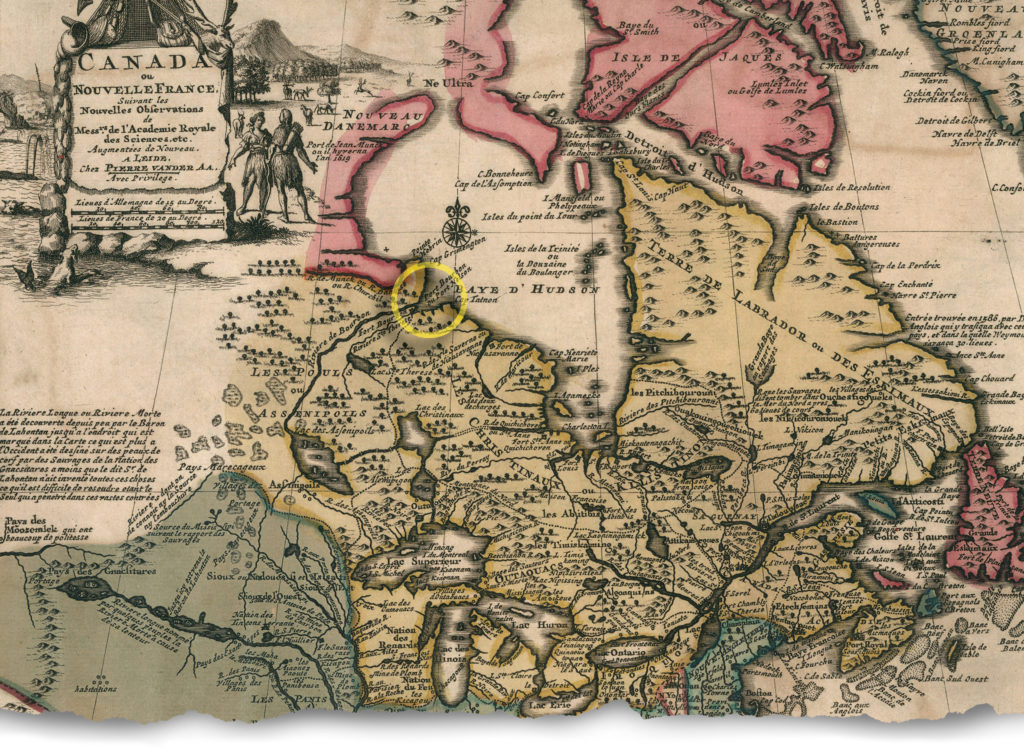
The 44-gun Pélican was at a distinct disadvantage, given that Hampshire carried 56 guns, Dering 36 and Royal Hudson’s Bay 32. Yet d’Iberville elected fight over flight. What ensued was an epic battle that would test the seamanship, wits and sheer mettle of the outnumbered and outgunned French captain.
Pélican immediately went on the offensive, engaging the English ships in a two-and-a-half-hour running sea battle. With superior tactics—and a healthy dose of luck—d’Iberville managed to not only escape initial destruction, but also inflict damage on the HBC ships. At the outset of the battle his gunners disabled Dering’s mainsail, and when Royal Hudson’s Bay came to the aid of its sister ship, Pélican similarly crippled the second company vessel. Having neutralized two enemy ships, d’Iberville was thus able to turn the engagement from a lopsided fight into a single-ship action.
Close-Range Combat
Naval warfare in the late 17th century was a haphazard venture. A captain’s seamanship, the prevailing conditions and, yes, luck were all contributing factors to victory at sea. Ships’ guns of the era were crude, inaccurate, prone to misfire and tended to inflict little damage at long range. Conventional naval tactics of the time thus dictated a warship first close on an opponent, raking the target vessel’s rigging and decks with cannon and musket fire, then use grappling hooks to draw it alongside. Armed boarding parties would then cross over and subdue the enemy crew in hand-to-hand combat. Captured vessels proved a source of additional supplies and, in some cases, replacement sailors.
At the climax of what became known as the Battle of Hudson Bay both Pélican and Hampshire adhered to such textbook tactics, pounding one another with round shot and small-arms fire for more than an hour, each attempting to disable the other. At the height of the action Fletcher reportedly yelled across the yards of water separating the warships, demanding d’Iberville surrender. The French commander refused, and Fletcher is reported to have raised a glass of wine in salute to his worthy foe. Hampshire’s captain did not have long to admire his foe, for as he tacked away from a Pélican broadside, the English frigate struck an uncharted shoal, broke up and sank with the loss of all hands.
At the sudden and unexpected destruction of Hampshire, the disabled Royal Hudson’s Bay lowered its flag and surrendered to Pélican even as Dering crowded on all sail and fled. As Pélican itself had been holed below the waterline in the exchange with Hampshire, d’Iberville was in no position to give chase.
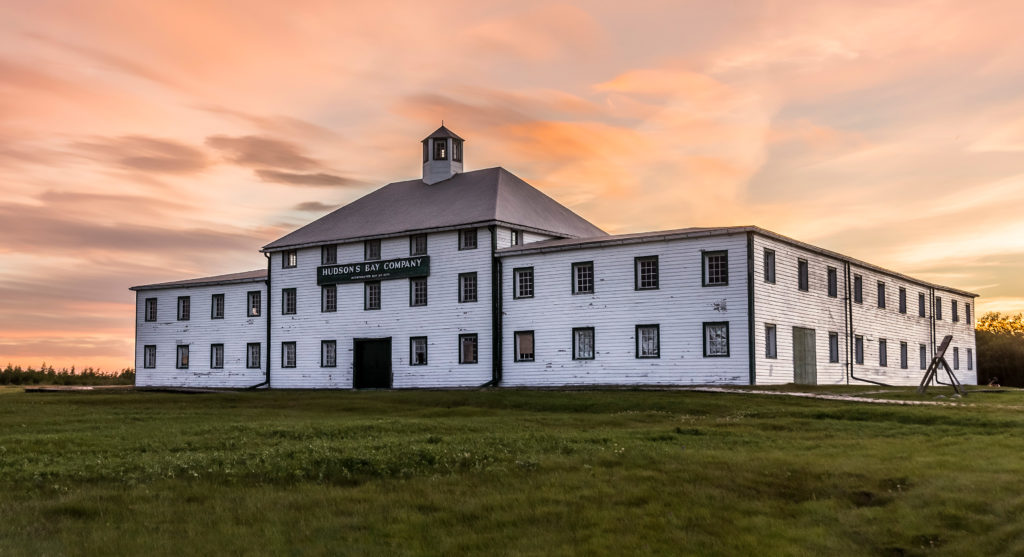
With the immediate English threat neutralized and foul weather closing in, d’Iberville concentrated on saving his surviving crew. Ordering Pélican run aground, he was able lead his men ashore through neck-deep icy water, though 18 died of exposure. Royal Hudson’s Bay also ran aground, its French prize crew and captive English sailors managing to wade ashore. Those English able to elude their captors made their way to the fort. Over the next few days d’Iberville and his men stripped Pélican of all useful items and awaited the French supply ships. Their arrival on September 8 provided d’Iberville sufficient men and materiel to besiege York Factory, which surrendered five days later.
With his victories at sea and on land d’Iberville had not only defeated a superior English naval force and captured York Factory, but also secured French primacy in Hudson Bay. The reach of the French empire in the New World now extended from the St. Lawrence River in the south to Hudson Bay in the north and east to the unclaimed lands of Labrador.
Aftermath
In his three volume Histoire du Canada (1845–48) French-Canadian writer François-Xavier Garneau judged that Pélican’s “splendid victory ensured the mastery on Hudson’s Bay to the French.” Unfortunately for his countrymen, d’Iberville’s triumph was ultimately overshadowed by the realities of a broader European conflict.
The Battle of Hudson Bay was a mere sideshow of the Nine Years’ War (aka War of the Grand Alliance or War of the League of Augsburg). That 1688–97 conflict pitted King Louis XIV’s France against a small European coalition that included William III’s England. Though fought mainly in continental Europe, the war spilled over to other contested regions, including North America and India. Some historians consider it the first truly global conflict. Complicating the terminology, the conflict that played out between English and French settlers and their respective Indian allies in the North American theater is commonly known as King William’s War.
With the 1713 signing of the Treaty of Utrecht, capping British victory in the follow-on Queen Anne’s War in North America, a defeated France recognized British sovereignty over Hudson Bay and its vast drainage and refocused its aspirations in Canada around the Great Lakes and the St. Lawrence River basin. Shortly after signing the treaty, France resettled its displaced colonists on Île Royale (present-day Cape Breton Island), bridging the Gulf of St. Lawrence and the Atlantic Ocean between British-held Acadia to the west and Newfoundland to the east. In 1719 the French founded the fishing port of Louisbourg, which by the 1740s had grown into one of the largest and most expensive fortified cities in Canada.
The ultimate fall of New France came amid the 1754–63 French and Indian War—a mere half century after the Treaty of Utrecht—with British Maj. Gen. James Wolfe’s masterful 1758 capture of Fortress Louisbourg and 1759 defeat of French Lt. Gen. Louis-Joseph de Montcalm on the Plains of Abraham. The latter cost both generals their lives and prompted the French evacuation of Quebec. With that, Britain became the dominant regional power, and the hard-won advances of d’Iberville and other French adventurers were consigned to the dustbin of history. Yet, for a short time France did legitimately hold vast swaths of the continent, and one cannot help but wonder how North American history might have evolved had France anchored and expanded its northern Canadian empire—fairly won by the gallant actions of d’Iberville and Pélican.
Jon Bradley is a retired associate professor with the faculty of education at Montreal’s McGill University. Sam Allison is a former high school history teacher and seasonal lecturer at McGill. For further reading they recommend Lemoyne d’Iberville: Soldier of New France, by Nellis M. Crouse; History of Canada, From the Time of Its Discovery Till the Union Year 1840–41, by François-Xavier Garneau; and The Royal Navy: A History From the Earliest Times to the Present, by William Laird Clowes.

